Table of Contents
Come join us now, and enjoy playing your beloved music and browse through great scores of every level and styles!
Can’t find the songbook you’re looking for? Please, email us at: sheetmusiclibrarypdf@gmail.com We’d like to help you!
Joe Hisaishi Hana-Bi (from Hana-Bi) sheet music, Noten, partitura, spartiti, partition, Joe Hisaishi 楽譜

Best Sheet Music download from our Library.

Please, subscribe to our Library.
If you are already a subscriber, please, check our NEW SCORES’ page every month for new sheet music. THANK YOU!
Joe Hisaishi 楽譜: The Maestro of Dreams – A Comprehensive Exploration
Browse in the Library:
Or browse in the categories menus & download the Library Catalog PDF:
Few composers in contemporary music possess the power to instantly evoke landscapes of emotion, memory, and pure imagination quite like Joe Hisaishi. Synonymous with the magical worlds of Studio Ghibli and the visionary films of Hayao Miyazaki, Hisaishi’s music transcends cultural boundaries, weaving intricate tapestries of sound that have captivated audiences worldwide for over four decades. His vast output extends far beyond animation, encompassing live-action films, solo albums, concert works, and global performances, solidifying his status as one of Japan’s most beloved and internationally renowned musical figures.
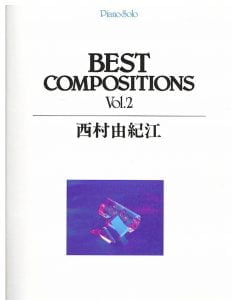
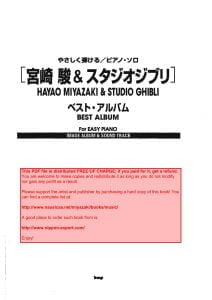

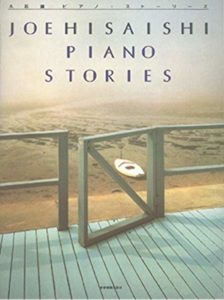


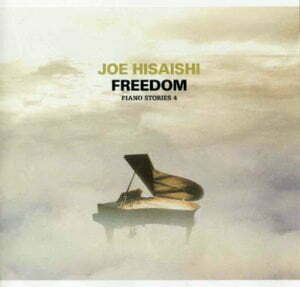
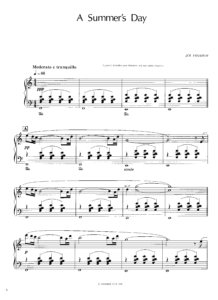








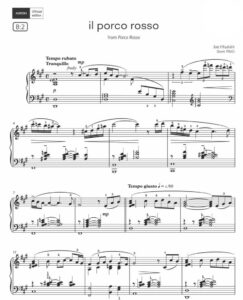
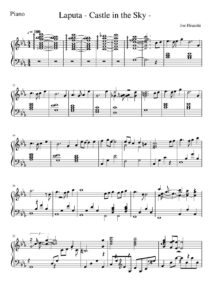
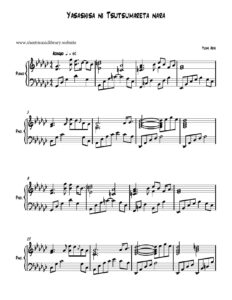

I. Biography: From Mamoru Fujisawa to Joe Hisaishi
- Birth and Early Life: Born Mamoru Fujisawa (藤澤 守) on December 6, 1950, in Nakano, Nagano, Japan. His musical journey began early, starting violin lessons at the age of five after being captivated by a performance.
- Formal Training: Recognizing his talent and passion, he pursued formal music education at the Kunitachi College of Music in Tokyo, graduating in 1969 with a major in music composition. He immersed himself in the works of classical masters while also developing a keen interest in contemporary minimalist music (Philip Glass, Terry Riley, Steve Reich) and Japanese electronic music pioneers.
- The Birth of “Joe Hisaishi”: In the early 1970s, as he began working as a composer and arranger for popular Japanese musicians (including gaining significant experience arranging for the electronic pop group “Wonder City Orchestra”), he adopted the stage name “Joe Hisaishi” (久石 譲). The name reflects both Western influence (“Joe”) and Japanese tradition (“Hisaishi” – a play on “Kuishi,” meaning “long time/eternity,” and “Ishi,” meaning “stone,” but also a reference to the American composer Quincy Jones – “Quincy” sounding like “Kuishi” in Japanese pronunciation).
- Early Career: Before film scoring fame, Hisaishi built a diverse foundation. He composed for avant-garde theater, created electronic music, released early solo albums (like the minimalist-influenced “MKWAJU” (1981) and “Information” (1982)), and arranged for idols and pop stars. This eclectic background became a hallmark of his later style.
II. Career Breakthrough: The Miyazaki and Ghibli Symphony
- The Fateful Meeting (1984): Hisaishi’s destiny changed irrevocably when he was invited to compose the score for Hayao Miyazaki’s animated film Nausicaä of the Valley of the Wind. Despite initial reservations from the production committee due to Hisaishi’s contemporary background, Miyazaki was deeply impressed by a demo cassette of Hisaishi’s electronic music. The resulting score, blending sweeping orchestral themes with synthesizers and choral elements, was a revelation, perfectly complementing the film’s epic scope and ecological themes. This marked the beginning of one of the most celebrated director-composer partnerships in cinematic history.
- Founding Studio Ghibli & Defining a Sound (1985 onwards): Following Nausicaä, Miyazaki, Isao Takahata, and Toshio Suzuki founded Studio Ghibli. Hisaishi became their primary composer, crafting the iconic scores for:
- Castle in the Sky (1986): Grand, adventurous, featuring the unforgettable main theme “Carrying You.”
- My Neighbor Totoro (1988): Whimsical, gentle, and deeply nostalgic, with the instantly recognizable “Path of the Wind” and the charming “Totoro” theme. The “Tonari no Totoro” song became a cultural phenomenon.
- Kiki’s Delivery Service (1989): Jazzy, uplifting, and sophisticated, reflecting Kiki’s coming-of-age journey in a European-inspired city.
- Porco Rosso (1992): Romantic, melancholic, and infused with Italian flair, featuring beautiful waltzes and poignant melodies.
- Princess Mononoke (1997): A monumental, complex, and powerful score blending traditional Japanese instruments (taiko drums, shakuhachi) with a massive Western orchestra, perfectly mirroring the film’s epic conflict between nature and industry. Tracks like “The Legend of Ashitaka” are concert staples.
- Spirited Away (2001): Ethereal, mysterious, and deeply moving. This score, featuring the haunting “One Summer’s Day” and the poignant “The Sixth Station,” won Hisaishi the Japanese Academy Award for Best Music and achieved global recognition alongside the film’s Oscar win. “Reprise” remains a standout concert piece.
- Howl’s Moving Castle (2004): Romantic, magical, and waltz-driven, featuring the beautiful main theme often performed as “Merry-Go-Round of Life.”
- Ponyo (2008): Playful, oceanic, and bursting with childlike wonder, centered around the simple yet infectious “Ponyo on the Cliff by the Sea.”
- The Wind Rises (2013): Elegiac, romantic, and historically resonant, featuring beautiful piano melodies reflecting the film’s biographical and dreamlike qualities.
- The Boy and the Heron (2023): A return to collaboration with Miyazaki, featuring a complex, mature, and often hauntingly beautiful score reflecting the film’s profound themes.
- Beyond Miyazaki at Ghibli: Hisaishi also scored Isao Takahata’s poignant Grave of the Fireflies (1988) and the charming Ocean Waves (1993) for the studio.
- The Partnership’s Essence: The Miyazaki-Hisaishi synergy is legendary. Hisaishi possesses an uncanny ability to translate Miyazaki’s visuals and narratives into pure musical emotion, often composing themes based on storyboards before filming even begins. Their mutual trust and shared artistic vision created a unique cinematic language where music is not just accompaniment but an integral, breathing part of the world.
III. Beyond Ghibli: A Prolific Film Composer
While Ghibli brought him global fame, Hisaishi’s filmography is vast and diverse, showcasing his incredible versatility:
- Takeshi Kitano Collaborations: A defining partnership in live-action cinema. Hisaishi’s scores for Kitano’s often violent yet poetic films provide a striking, beautiful counterpoint:
- Violent Cop (1989), Boiling Point (1990), A Scene at the Sea (1991 – featuring the famous “Silent Love”), Sonatine (1993), Getting Any? (1994), Kids Return (1996), Hana-Bi (1997 – Winner of the Golden Lion at Venice; Hisaishi won the Japanese Academy Award), Kikujiro (1999 – featuring the beloved “Summer”), Brother (2000), Dolls (2002), Zatoichi (2003), Takeshis’ (2005), Glory to the Filmmaker! (2007), Achilles and the Tortoise (2008), Outrage series (2010-2017).
- Other Notable Japanese Films:
- The Silk Road (1988) – Epic historical score.
- Haru (1996)
- Welcome Back, Mr. McDonald (1997)
- Spy Sorge (2003)
- Departures (2008 – Academy Award winner for Best Foreign Language Film; Hisaishi’s score was widely acclaimed).
- I Am a Monk series (2009, 2011, 2015)
- Chronicle of My Mother (2011)
- The Emperor in August (2015)
- What a Wonderful Family! series (2016, 2017, 2018)
- International Projects:
- Le Petit Poucet (Tom Thumb) (2001) – French film.
- Chinese Odyssey 2002 (2002) – Hong Kong film.
- Dragon Hunters (2008) – French-German-Luxembourgish animated film.
- The Sun (2005) – Russian-Japanese film about Emperor Hirohito.
- The Tale of The Princess Kaguya (2013) – Despite being Ghibli (directed by Takahata), this deserves mention for its unique, minimalist score using traditional Japanese instruments almost exclusively, a stark departure from his Ghibli norm.
IV. Musical Style and Characteristics
Hisaishi’s style is instantly recognizable yet remarkably adaptable. Key characteristics include:
- Melodic Genius: His primary strength lies in crafting unforgettable, soaring, and deeply emotive melodies that lodge in the listener’s heart (“One Summer’s Day,” “The Legend of Ashitaka,” “Summer,” “Hana-Bi,” “Merry-Go-Round of Life”).
- Orchestral Mastery: He writes lush, complex, and often large-scale orchestral arrangements, demonstrating a profound understanding of instrumental color and texture.
- Minimalist Influences: His early grounding in minimalism surfaces in repetitive rhythmic patterns, evolving ostinatos, and the use of simple harmonic progressions to build powerful emotional climaxes (evident in scores like Nausicaä, Princess Mononoke, and his solo work).
- Eclectic Fusion: He seamlessly blends Western classical orchestration with electronic elements, traditional Japanese instruments (koto, shakuhachi, taiko), jazz harmonies, pop sensibilities, and global influences.
- Emotional Resonance: His music has an unparalleled ability to evoke a vast spectrum of emotions – profound wonder, exhilarating joy, deep melancholy, tranquil peace, and thrilling adventure – often within the same piece.
- Piano Focus: The piano is often a central voice in his compositions, both in film scores and solo works, reflecting his own instrument and love for it.
V. Beyond Film: Solo Works, Concertos, and Orchestral Music
Hisaishi is not solely a film composer. He maintains a vibrant parallel career as a concert artist:
- Solo Albums: Releasing numerous albums since the early 1980s, exploring electronic, new age, jazz, and classical styles. Key works include “MKWAJU,” “Information,” “Piano Stories” series (Vol. I-V), “Minima_Rhythm,” “Another Piano Stories – The End of the World,” “Encore,” “Melodyphony,” and “Minima_Rhythm II.”
- Concertos and Symphonic Works: He has composed significant concert works, often premiering them himself as conductor or pianist:
- Concerto for String Quartet and Orchestra (1991)
- Symphony No. 1 “East Land Symphony” (1992)
- Symphony No. 2 (1997)
- Concerto for Piano and Orchestra “Asian X.T.C.” (1998)
- Symphony No. 3 “Symphonic Trilogy” (2004)
- Concerto for Violin and Orchestra “The Borderline” (2005)
- Piano Concerto “The East Land” (2008)
- Symphony No. 4 (2011)
- Concerto for Harp and Orchestra (2017)
- Symphony No. 5 (2021)
- Chamber Music: Including works for string quartet and smaller ensembles.
- Stage Works: Composing for ballet and theater productions.
VI. The Conductor and Performer
Hisaishi is a dynamic presence on the concert stage:
- He regularly conducts major orchestras worldwide (London Symphony Orchestra, New Japan Philharmonic, Czech Philharmonic, etc.) in performances of his film music and concert works.
- He frequently performs as a pianist in his own compositions and in solo recitals featuring his works.
- His “Joe Hisaishi Symphonic Concert – Music from the Studio Ghibli Films of Hayao Miyazaki” tours are massive global events, selling out iconic venues like the Budokan, Royal Albert Hall, and Accor Arena (Bercy), featuring full orchestra and choir, and often Miyazaki film montages.
VII. Discography (Selected Highlights – A Fraction of the Total)
Hisaishi’s discography is immense, spanning hundreds of releases. Here are landmark albums:
- Solo Albums: MKWAJU (1981), Information (1982), Piano Stories (1988), I Am (1989), Pretender (1990), My Lost City (1992), Piano Stories II: The Wind of Life (1996), Works I & Works II (compilations, 1997), Shoot the Violist (2003), Piano Stories III: Nostalgia (1998), Encore (2002), Freedom: Piano Stories 4 (2005), Asian X.T.C. (2006), Another Piano Stories – The End of the World (2009), Melodyphony: Best of Joe Hisaishi (2010), Minima_Rhythm (2011), Minima_Rhythm II (2013), The End of the World – Piano Stories 2009 (2015), Minima_Rhythm III (2023).
- Studio Ghibli Soundtracks: Nausicaä of the Valley of the Wind (1984), Castle in the Sky (1986), My Neighbor Totoro (1988), Kiki’s Delivery Service (1989), Porco Rosso (1992), Princess Mononoke (1997), Spirited Away (2001), Howl’s Moving Castle (2004), Ponyo (2008), The Wind Rises (2013), The Boy and the Heron (2023). Grave of the Fireflies (1988), Ocean Waves (1993).
- Takeshi Kitano Soundtracks: A Scene at the Sea (1991), Sonatine (1993), Kids Return (1996), Hana-Bi (1997), Kikujiro (1999), Dolls (2002), Zatoichi (2003).
- Other Key Soundtracks: The Silk Road (1988), Departures (2008), The Sun (2005), The Tale of The Princess Kaguya (2013).
- Concert Albums: Joe Hisaishi Symphonic Concert 2003, Joe Hisaishi in Budokan: Studio Ghibli 25 Years Concert (2008), The Best of Cinema Music (2009), Dream Songs: The Essential Joe Hisaishi (2013), Symphonic Suite “Princess Mononoke” (2014), A Symphonic Celebration (Live – LSO, 2017), Minima_Rhythm in Seoul (Live, 2023).
VIII. Filmography (Selected – Highlighting Major Works)
- 1984: Nausicaä of the Valley of the Wind
- 1986: Castle in the Sky
- 1988: My Neighbor Totoro, Grave of the Fireflies
- 1989: Violent Cop, Kiki’s Delivery Service
- 1990: Boiling Point
- 1991: A Scene at the Sea
- 1992: Porco Rosso, Haru
- 1993: Sonatine, Ocean Waves
- 1994: Getting Any?
- 1996: Kids Return
- 1997: Princess Mononoke, Hana-Bi, Welcome Back, Mr. McDonald
- 1999: Kikujiro
- 2000: Brother
- 2001: Spirited Away, Le Petit Poucet
- 2002: Dolls, Chinese Odyssey 2002
- 2003: Zatoichi, Spy Sorge
- 2004: Howl’s Moving Castle
- 2005: The Sun
- 2008: Ponyo, Departures, Dragon Hunters
- 2009: I Am a Monk
- 2010: Outrage
- 2011: Chronicle of My Mother, Outrage Beyond
- 2013: The Wind Rises, The Tale of The Princess Kaguya
- 2015: The Emperor in August, Outrage Coda
- 2016: What a Wonderful Family!
- 2017: What a Wonderful Family! 2, What a Wonderful Family! 3
- 2018: What a Wonderful Family! 4
- 2021: Masked Ward
- 2023: The Boy and the Heron, Godzilla Minus One (Theme Music – “Godzilla Minus One Suite”)
IX. Accolades and Legacy
- Awards: 7 Japanese Academy Awards for Best Music (Princess Mononoke, Hana-Bi, Spirited Away, Howl’s Moving Castle, Departures, The Boy and the Heron, Godzilla Minus One), numerous other Japanese film and music awards. Golden Globe nomination for Best Original Score (Spirited Away). Academy Award nomination for Best Original Score (The Boy and the Heron, 2024).
- Global Impact: Hisaishi’s music, particularly through Ghibli, has introduced millions worldwide to the beauty of orchestral film music and Japanese composition. His concerts draw massive international audiences.
- Cultural Icon: In Japan, he is a household name. Melodies like “Tonari no Totoro” and “Summer” are deeply ingrained in popular culture.
- Artistic Legacy: He redefined the possibilities of film music in Japanese cinema, blending genres and emotions with unmatched skill. His work with Miyazaki created a unique sonic universe integral to the magic of Ghibli. His concert works continue to expand his artistic voice.
- Humanitarian Work: He is known for supporting charitable causes, including performing benefit concerts after disasters like the 2011 Tōhoku earthquake and tsunami.
X. Joe Hisaishi: The Eternal Composer
Joe Hisaishi is more than a composer; he is an architect of feeling. His music possesses the rare quality of feeling simultaneously intimate and epic, deeply personal yet universally resonant. Whether capturing the boundless wonder of childhood in Totoro, the tragic beauty of Hana-Bi, the epic struggle of Princess Mononoke, or the delicate melancholy of The Wind Rises, Hisaishi translates the ineffable into sound. His collaboration with Miyazaki gifted the world with some of the most cherished musical moments in film history, but his prolific output across film, concert hall, and recording studio reveals an artist of boundless creativity and profound depth. From the minimalist experiments of his youth to the grand symphonic canvases of today, Joe Hisaishi continues to compose the soundtrack to our dreams, reminding us of the transformative and enduring power of music. He is, truly, a maestro for the ages.
Browse in the Library:
Or browse in the categories menus & download the Library Catalog PDF:
楽譜 Joe Hisaishi Hana-Bi
Here is a detailed musical analysis of Joe Hisaishi’s score for Takeshi Kitano’s “Hana-bi” (Fireworks) (1997), a film renowned for its stark beauty, profound melancholy, and exploration of violence, guilt, love, and redemption.
Context is Crucial
- Film’s Tone: “Hana-bi” is characterized by extreme contrasts: sudden brutal violence juxtaposed with serene, almost meditative stillness; profound sadness alongside moments of quiet joy and tenderness; stoic silence punctuated by explosive action. Kitano’s visual style is minimalist, deliberate, and often painterly.
- Director-Composer Dynamic: Kitano and Hisaishi share a unique artistic synergy, distinct from Hisaishi’s work with Miyazaki. Kitano often gives Hisaishi significant freedom, sometimes incorporating the music early in the editing process. Hisaishi’s music doesn’t just accompany the images; it often defines the emotional landscape and internal states of the characters, particularly the taciturn protagonist, Nishi.
Core Musical Themes & Motifs
Hisaishi employs a relatively small set of core musical ideas developed with exquisite subtlety and emotional depth throughout the score:
- The “Nishi & Miyuki” Theme (Main Theme / “Hana-bi”):
- Instrumentation: Primarily solo piano, sometimes doubled or supported by strings (often just cello or a small string section), and occasionally featuring a solo violin or accordion.
- Melody: A simple, profoundly melancholic, yet achingly beautiful melody. It’s built on stepwise motion and gentle leaps, often centered around a minor key (frequently E minor or D minor), conveying deep sorrow, resignation, and tenderness. Its simplicity makes it incredibly potent.
- Harmony: Uses basic triads (major and minor) and suspended chords (sus2, sus4) creating a sense of unresolved tension, longing, and fragility. Progressions are often cyclical and repetitive, reflecting Nishi’s trapped emotional state and the cyclical nature of grief. Modulations subtly shift the emotional color.
- Rhythm/Tempo: Slow (Adagio or Lento), rubato (with expressive freedom in tempo), and sparse. The spaces between notes are as important as the notes themselves, mirroring Kitano’s visual pauses and Nishi’s internal silence.
- Texture: Predominantly homophonic (melody with chordal accompaniment) and thin. The sparseness emphasizes isolation and vulnerability. When strings enter, they often play sustained chords or double the piano line, adding warmth but also weight.
- Function: Represents the core relationship between Nishi and his terminally ill wife, Miyuki. It embodies their shared pain, quiet love, stolen moments of peace, and the looming tragedy. It’s the heart of the film’s emotional core.
- The “Violence & Guilt” Motif / “Fireworks”:
- Instrumentation: Full orchestra (heavy on brass, percussion, low strings), sometimes incorporating synthesized textures or prepared piano sounds for harshness.
- Melody: Often fragmented, angular, or dissonant. Less a singable melody, more a collection of jarring gestures, clusters, or percussive hits.
- Harmony: Extremely dissonant, using clusters, tritones, and unresolved tensions. Creates a sense of shock, brutality, and psychological trauma.
- Rhythm/Tempo: Sudden, explosive, irregular, and often complex. Features sharp staccato attacks, rapid tremolos, and pounding percussion (especially timpani and bass drum). Tempo can be frenetic or grindingly slow.
- Texture: Dense and powerful, overwhelming the listener, mirroring the sudden impact of violence. Can also be starkly minimalistic in moments of cold aftermath.
- Function: Represents the eruptions of violence (past and present), Nishi’s traumatic memories (particularly the death of his partner), his underlying rage, and the crushing weight of guilt and responsibility he carries. The track titled “Fireworks” is the most direct manifestation.
- The “Police / Mundane World” Theme:
- Instrumentation: Often features acoustic guitar, light percussion (shaker, brushed snare), sometimes bass guitar, occasionally woodwinds (clarinet, flute) or light strings.
- Melody: Generally more conventional, sometimes slightly quirky or melancholic, but often neutral or detached.
- Harmony: Simpler progressions, often in major keys, but can feel slightly hollow or melancholic underneath.
- Rhythm/Tempo: Moderate tempos, often with a light groove or a march-like feel.
- Texture: Lighter than the other themes, often contrapuntal (different lines interweaving).
- Function: Represents the everyday world of the police station, Nishi’s colleagues (Horibe, Tanaka), and the mundane reality Nishi is increasingly detached from. It provides contrast and context. Tracks like “Nishi and Horibe” or “Play on the Sands” often utilize this.
- Horibe’s “Art & Redemption” Theme:
- Instrumentation: Frequently features a solo cello or viola, sometimes solo piano or accordion, and later fuller strings.
- Melody: Lyrical, contemplative, often rising in contour, conveying a sense of searching, emerging feeling, and fragile hope. Less overtly tragic than the main theme.
- Harmony: Can be melancholic but often resolves more peacefully than the main theme. Uses suspensions effectively for poignancy.
- Rhythm/Tempo: Slow to moderate, flowing.
- Texture: Often starts monophonic (single line) or sparse, gradually thickening as his artistic spirit awakens.
- Function: Represents Horibe’s journey after his paralysis – his despair, his discovery of painting, and the glimmer of meaning and redemption he finds through art. Tracks like “Smile and Smile” or “Face to Face” embody this. It provides a counterpoint to Nishi’s descent.
Key Techniques & Stylistic Elements
- Minimalism as Emotional Amplifier: Hisaishi uses minimalist techniques masterfully:
- Repetition: Simple melodic phrases and harmonic progressions repeat, creating a hypnotic, meditative, or trapped feeling. This reflects Nishi’s cyclical thoughts and the inescapable nature of his fate.
- Sparse Texture: The vast amount of space (silence) around the notes forces the listener to focus intensely on each sound, amplifying its emotional weight. This mirrors Kitano’s visual minimalism and Nishi’s internal world.
- Slow Tempo & Rubato: Allows time for emotions to resonate and emphasizes the weight of each moment.
- Ostinatos: Repeating bass lines or rhythmic patterns (often subtle) provide a foundation of unease or inevitability beneath the melodies.
- Strategic Dissonance: Hisaishi doesn’t shy away from harshness when needed (“Fireworks”), but it’s always purposeful and contrasted sharply with moments of extreme consonance and beauty. This reflects the film’s core duality.
- Instrumentation as Character: The choice of instrument directly conveys emotion:
- Solo Piano: Intimacy, vulnerability, introspection, Nishi’s inner voice.
- Strings (Solo or Section): Warmth, sorrow, lyricism, emotional depth (both for Nishi/Miyuki and Horibe).
- Accordion: Loneliness, nostalgia, a touch of the everyday or folk-like, sometimes bittersweet.
- Full Orchestra (Brass/Percussion): Violence, trauma, overwhelming force, societal pressure.
- Acoustic Guitar: The mundane world, everyday interactions, sometimes a touch of wistfulness.
- Silence as a Compositional Element: The pauses, the held breaths, the moments where only ambient sound remains are crucial. Hisaishi and Kitano understand that what is not said musically is as powerful as what is played. This silence reflects Nishi’s stoicism and the unspeakable nature of his pain.
- Development Through Simplicity: The themes themselves are not complex, but Hisaishi develops them through subtle variations in:
- Orchestration: Shifting which instruments carry the melody or harmony changes the color and weight.
- Harmony: Modulating to a different key, changing a chord from major to minor (or vice versa, though rare), or altering the bass note significantly alters the emotional context.
- Texture: Adding or removing layers changes the intensity and intimacy.
- Rhythmic Placement: Playing the same motif slightly ahead or behind the beat creates subtle tension.
Analysis of Key Tracks
- “Hana-bi” (Opening Title): Establishes the core main theme on solo piano. Stark, melancholic, beautiful. Sets the film’s tone immediately. The simplicity is devastating.
- “Angel” (Horibe’s Accident): A powerful example of the “Violence” motif. Starts with low, ominous strings and percussion, building tension before erupting into dissonant brass clusters, pounding timpani, and frantic strings – musically depicting the sudden, brutal impact of the shooting. Abruptly ends, leaving silence and shock.
- “Everlasting” (Nishi & Miyuki at Lake): Perhaps the most famous track. A fuller orchestral rendition of the main theme (strings prominent). While lush, it retains profound sadness and a sense of doomed beauty. Repetitive structure reinforces the fleeting nature of this peaceful moment.
- “Play on the Sands” (Nishi & Miyuki Playing): Uses the lighter “Mundane World” instrumentation (guitar, light percussion, bass). A rare moment of gentle, almost childlike playfulness and connection. The melody is simple and slightly melancholic underneath the surface cheer.
- “Smile and Smile” (Horibe Painting): Embodies Horibe’s theme. Starts sparse (cello?), contemplative, searching. Gradually builds with strings, becoming more lyrical and hopeful as he finds purpose in painting. A counter-melody of quiet determination emerges.
- “Fireworks” (Final Confrontation): The culmination of the “Violence” motif. A complex, terrifying orchestral onslaught. Dissonant brass shrieks, pounding irregular rhythms, swirling strings, and brutal percussion create a soundscape of chaos, rage, and finality. It’s musically overwhelming, reflecting the extremity of Nishi’s actions.
- “Memory” (End Credits): A final, heartbreakingly beautiful reprise of the main theme, often on solo piano or piano with light strings. It’s a lament, a remembrance, imbued with a sense of acceptance tinged with infinite sadness. The repetition feels like a final, lingering echo.
Music as the Unspoken Emotion
Joe Hisaishi’s score for “Hana-bi” is a masterpiece of minimalism and emotional precision. It succeeds brilliantly because it:
- Complements Kitano’s Aesthetic: The sparseness, silence, and deliberate pacing mirror the director’s visual style perfectly.
- Gives Voice to the Voiceless: It articulates the profound depths of Nishi’s grief, guilt, love, and resolve that he cannot express verbally.
- Creates Emotional Counterpoint: The beautiful, fragile melodies set against the harsh reality of violence and the mundane world create the film’s unique, devastating power.
- Uses Simplicity as Strength: The core themes are memorable and direct, allowing their development through subtle variations to carry immense weight.
- Integrates Silence: Understands that silence is not emptiness, but a resonant space for the audience to feel.
Hisaishi doesn’t just score the actions in “Hana-bi”; he scores the silences, the glances, the internal landscapes, and the overwhelming weight of unspoken emotion. The music is the soul of the film, transforming Kitano’s stark visuals into a deeply moving and unforgettable experience. It stands as one of the most potent collaborations in film history and a pinnacle of Hisaishi’s art.
